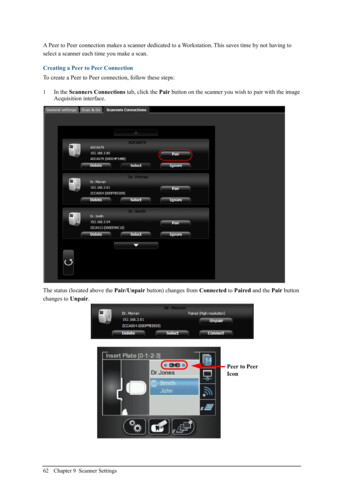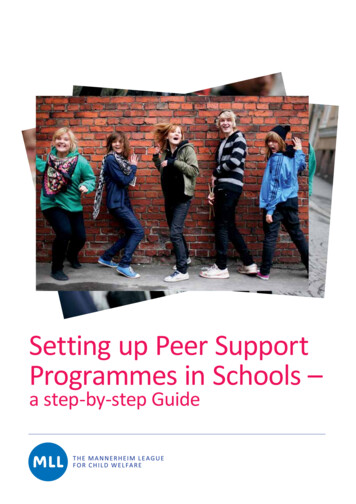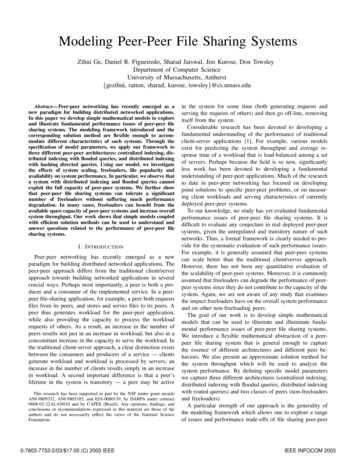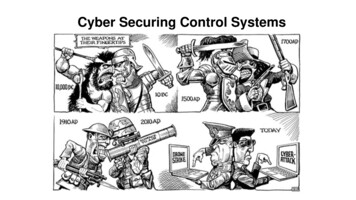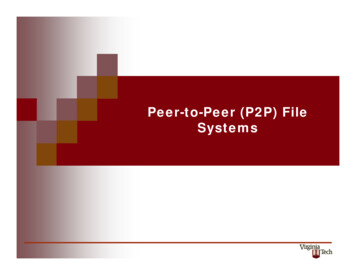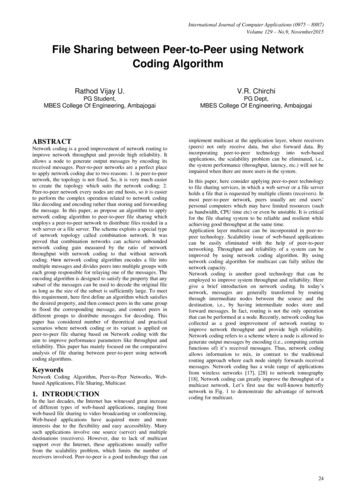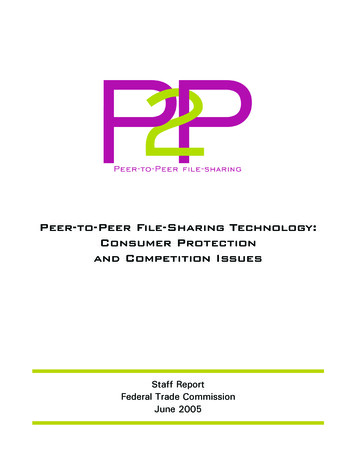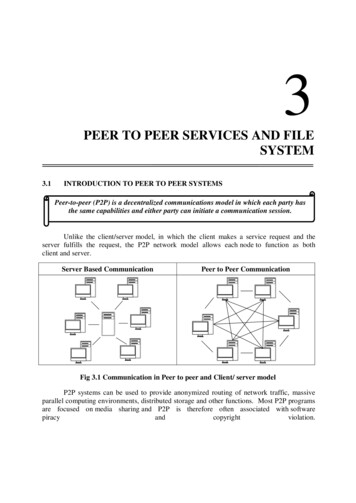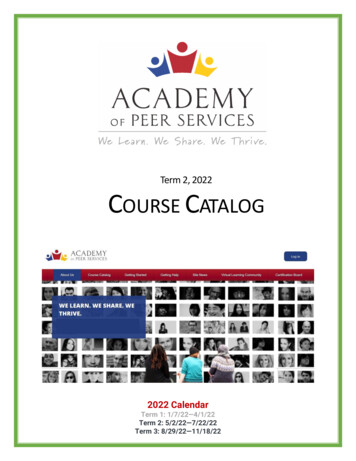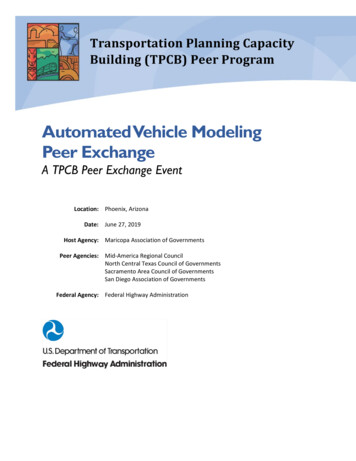
Transcription
Transportation Planning CapacityBuilding (TPCB) Peer ProgramAutomated Vehicle ModelingPeer ExchangeA TPCB Peer Exchange EventLocation: Phoenix, ArizonaDate: June 27, 2019Host Agency: Maricopa Association of GovernmentsPeer Agencies: Mid-America Regional CouncilNorth Central Texas Council of GovernmentsSacramento Area Council of GovernmentsSan Diego Association of GovernmentsFederal Agency: Federal Highway Administration
NoticeThis document is disseminated under the sponsorship of the Department of Transportation in theinterest of information exchange. The United States Government assumes no liability for thecontents or use thereof.The United States Government does not endorse products or manufacturers. Trade ormanufacturers’ names appear herein solely because they are considered essential to theobjective of this report.Automated Vehicle Modeling Peer Exchangei
REPORT DOCUMENTATION PAGEOMB No.Public reporting burden for this collection of information is estimated to average 1 hour per response, including the time for reviewing instructions, searching existing data sources,gathering and maintaining the data needed, and completing and reviewing the collection of information. Send comments regarding this burden estimate or any other aspect of thiscollection of information, including suggestions for reducing this burden, to Washington Headquarters Services, Directorate for Information Operations and Reports, 1215 JeffersonDavis Highway, Suite 1204, Arlington, VA 22202-4302, and to the Office of Management and Budget, Paperwork Reduction Project (0704-0188), Washington, DC 20503.1. AGENCY USE ONLY (Leave blank)3. REPORT TYPE AND DATES COVERED2. REPORT DATESeptember 2019Final (June 2019)4. TITLE AND SUBTITLE5a. FUNDING NUMBERSAutomated Vehicle Modeling Peer Exchange: A TPCB Peer Exchange EventHW2LA4/SG6286. AUTHOR(S)5b. CONTRACT NUMBER7. PERFORMING ORGANIZATION NAME(S) AND ADDRESS(ES)8. PERFORMING ORGANIZATIONREPORT NUMBERRachel Strauss McBrienU.S. Department of TransportationJohn A. Volpe National Transportation Systems Center55 BroadwayCambridge, MA 02142-1093DOT-VNTSC FHWA-19-259. SPONSORING/MONITORING AGENCY NAME(S) AND ADDRESS(ES)10. SPONSORING/MONITORINGAGENCY REPORT NUMBERU.S. Department of TransportationFederal Highway AdministrationOffice of Planning1200 New Jersey Avenue, SEWashington, DC 20590FHWA-HEP-20-00611. SUPPLEMENTARY NOTES12a. DISTRIBUTION/AVAILABILITY STATEMENTThis report is publicly available on the TPCB website at: www.planning.dot.gov.12b. DISTRIBUTION CODE13. ABSTRACT (Maximum 200 words)This report summarizes proceedings of an Automated Vehicle (AV) modeling peer exchange sponsored by the Federal Highway Administration(FHWA) and hosted by the Maricopa Association of Governments in Phoenix, AZ, on June 27, 2019. The purpose of the peer exchange was todiscuss the potential impacts of emerging technologies, such as AVs, on the long-range transportation planning process. Five peers frommetropolitan planning organizations across the country participated to share their experiences and perspectives. The event was sponsored byFHWA through its Transportation Planning Capacity Building Program, led in partnership with the Federal Transit Administration.14. SUBJECT TERMSKeywords: Modeling, automated vehicle, emerging technologies, disruptive technologies, long-rangetransportation planning, metropolitan planning organizations, data, scenarios, assumptions17. SECURITY CLASSIFICATIONOF REPORTUnclassified18. SECURITY CLASSIFICATIONOF THIS PAGEUnclassifiedNSN 7540-01-280-5500Automated Vehicle Modeling Peer Exchange19. SECURITY CLASSIFICATIONOF ABSTRACTUnclassified15. NUMBER OF PAGES3216. PRICE CODE20. LIMITATION OF ABSTRACTUnlimitedStandard Form 298 (Rev. 2-89)Prescribed by ANSI Std. 239-18298-102ii
Table of ContentsList of Figures . ivExecutive Summary. 1Overview of the Peer Exchange . 2Goals of the Peer Exchange . 2Participating Peers . 2Format of the Event . 2Presentation Highlights . 3Welcome and Introduction . 3Purpose of Peer Exchange . 3Report on Recent Events and Resources . 4Peer Approaches to AV Modeling . 5Sacramento Area Council of Governments. 6Maricopa Association of Governments. 7San Diego Association of Governments . 8Mid-America Regional Council . 10North Central Texas Council of Governments . 11Discussion Topics . 12Managing Risk and Uncertainty in Modeling . 13Communicating Model Results . 14Modeling Information Gaps and Resource Needs . 15Conclusion . 17Appendices. 18Appendix A: Key Contacts . 18Appendix B: Event Participants . 19Appendix C: Peer Exchange Agenda . 20Appendix D: Risk Factors. 23Appendix E: Acronyms . 26Automated Vehicle Modeling Peer Exchangeiii
List of FiguresFigure 1: Participants listen during a peer's presentation. . 5Figure 2: Evolution of SANDAG’s ABM from 2013 to present. . 9Figure 3: MARC’s four transportation scenarios. 10Figure 4: NCTCOG’s approach for incorporating AVs into its four-step model. . 12Automated Vehicle Modeling Peer Exchangeiv
Executive SummaryThis report highlights noteworthy practices and discussions shared during a one-day peer exchange onAutomated Vehicle (AV) modeling, held June 27, 2019, in Phoenix, Arizona, and hosted by the MaricopaAssociation of Governments. The Federal Highway Administration (FHWA) sponsored the peer exchangethrough its Transportation Planning Capacity Building (TPCB) Peer Program, which is run jointly with theFederal Transit Administration. The program promotes knowledge transfer on transportation planningtopics through peer learning opportunities. Contact information for the FHWA representatives involvedin peer exchange planning as well as the peer exchange peers and presenters is included in Appendix Aof this report.With increasing interest in AVs and the potential impacts they stand to have on the Nation’stransportation network, many transportation agencies, including Metropolitan Planning Organizations(MPOs), are actively exploring ways to address AV modeling considerations in the long-rangetransportation planning process. The peer exchange brought together five MPOs to discuss theirapproaches to AV modeling. Insights shared during the peer exchange do not necessarily reflect theopinions of FHWA.The following MPO representatives served as the peers for the event: Bruce Griesenbeck, Data and Analysis Manager, Sacramento Area Council of Governments(SACOG) (Sacramento, CA);Vladimir Livshits, Ph.D., Director of Transportation Technologies, Maricopa Association ofGovernments (MAG) (Phoenix, AZ);Arash Mirzaei, Transportation System Modeling Manager, North Central Texas Council ofGovernments (NCTCOG) (Arlington, TX);Wu Sun, Ph.D., Principal Researcher and Modeler, San Diego Association of Governments(SANDAG) (San Diego, CA); andEileen Yang, Transportation Modeling Manager, Mid-America Regional Council (MARC) (KansasCity, MO).The peers presented information about their agencies’ AV modeling activities and the context in whichthey are doing modeling. The peers also participated in discussions throughout the peer exchange on avariety of topics, including (1) managing risk and uncertainty in modeling; (2) communicating modelresults; and (3) modeling information gaps and resource needs.The presentations and discussion resulted in key takeaways, including: There is tremendous uncertainty about the impacts AVs will have on future transportationsystems. Behavioral travel models are among the few tools that may provide useful mechanismsfor conceptualization of the effect of these technologies.Using models can allow for more informed decisionmaking, recognizing that models provideinsights and not answers. Every model has underlying assumptions and data. Models are a wayto quantify the future and can provide a consistent set of metrics to explore scenarios reflectingvarious assumptions (e.g., land use, socioeconomic data, etc.).Automated Vehicle Modeling Peer Exchange1
Scenario testing can make the most of AV modeling compared to other more specific forecastingtechniques due to the approach’s flexibility in exploring outcomes of multiple, varied futures.Organizing estimates of “uncertainty” factors in the modeling chain by category of assumptionscould help MPO modelers better understand how the factors relate and potentially impact eachother.Presenting model results and related information should include consequential assumptionsabout the model and external inputs. This method of communication provides a meaningfulcontext for interpretation of the model results. In addition, it is important to keep the targetaudience in mind so that the model’s underlying assumptions and data can be communicatedeffectively.Data interpretation is the foundation of travel modeling and is a significant skillset needed formodeling professionals. New data, new applications, and new data management approaches areemerging from AVs and other new technologies.Overview of the Peer ExchangeGoals of the Peer ExchangeFHWA organized the peer exchange to bring together MPO technical modelers who are leaders in thefield of AV modeling to discuss how they are addressing AV modeling considerations in the long-rangetransportation planning process. FHWA sponsored the peer exchange through its TPCB Peer Program.FHWA designed the peer exchange to benchmark current practices among MPO technical modelers inmodeling AV and identify near-term actions to address existing challenges and knowledge gaps. As thepeers participating in the peer exchange all had deep modeling experience, FHWA additionally sought toobtain their ideas on key considerations, challenges, and opportunities for future resources to furtheraddress AV modeling in the long-range transportation planning processParticipating PeersThe peer exchange included five peer MPO representatives, all of whom have extensive experience inmodeling and are now thinking about AV modeling considerations. The five peer agencies were MAG,MARC, NCTCOG, SACOG, and SANDAG.Format of the EventMAG hosted the one-day peer exchange in Phoenix, Arizona, on June 27, 2019. The five peer presenters,FHWA staff, and other partners, including the Arizona Department of Transportation, attended theworkshop. A full list of attendees is available in Appendix B of this report.The peers first shared information about their agencies’ approach to AV modeling and the context inwhich they are doing modeling. The subsequent discussion was then organized around the topics of (1)managing risk and uncertainty in modeling; (2) communicating model results; and (3) modelinginformation gaps and resource needs.The agenda for the peer exchange is provided in Appendix C of this report.Automated Vehicle Modeling Peer Exchange2
Presentation HighlightsWelcome and IntroductionJeremy Raw, Community Planner with the FHWA Office of Planning, Karla Petty, FHWA Arizona DivisionAdministrator, and Eric Anderson, MAG Executive Director, opened the peer exchange. The FHWA Officeof Planning is interested in learning from MPOs that have metropolitan transportation plans (MTPs) thatreference the emergence of AVs. Mr. Raw raised that there is tremendous uncertainty around thisemergence.Executive Director Anderson emphasized that models do not give answers; rather, they provide insights.MPOs and other transportation agencies and stakeholders look to the models to give insight into howdifferent decisions might impact the world in which we live. Models are tools to help us sift throughtheories and methodologies; they do not have the answers. This theme of “models providing insights,not answers” would carry through the rest of the peer exchange.Division Administrator Petty discussed that Arizona is a leader in the field of AV testing and MAG is atthe forefront of AV modeling. Several AV companies are testing their technologies in Arizona and in theMAG region. There are automated trucks driving on the State’s freeway systems and within thecommunity. Ms. Petty noted that there are many questions and unknowns surrounding AVs andrecognized peer exchange participants for focusing on these uncertainties. She reiterated theimportance of using models to allow for informed decisionmaking and highlighted the potential value ofAVs in improving roadway safety.Purpose of Peer ExchangeSeveral web-based meetings among the peers and facilitated by FHWA preceded the peer exchange.These “virtual” meetings allowed for the peers to share information with each other and what theyhoped to gain from the peer exchange.One of the goals of the peer exchange was to discuss what MPOs can reasonably do in light of theuncertainty in modeling AVs in their long-range transportation planning process and how they might goabout this modeling. For example, MPOs traditionally have used models, in part, to build scenariosaround land use conditions and not usually around changes in trip purposes or travel behavior. 1 Thegrowth of AVs potentially creates a situation where “core” assumptions once thought not to changebecome potentially more likely to change (e.g., changes in travel behavior, goods movement). Mr. Rawnoted that models can inform how the world might work in the future but not about how it will work.As part of the MTP development, MPOs work with their stakeholders to envision where a community isheaded and identify goals for the future. MPO modelers are responsible for processing this informationthrough models based on different sets of assumptions. Decisionmakers often use the results of themodels to help inform their decisionmaking. Explaining and understanding these assumptions can bechallenging, particularly as the model is not the end of asking questions but rather the beginning to helpfind answers.The peer exchange specifically focused on specific travel demand modeling considerations, as opposed to broader scenario planningconsiderations. Additional information on scenario planning is available on the FHWA Scenario Planning website at:https://www.fhwa.dot.gov/planning/scenario and visualization/scenario planning/.1Automated Vehicle Modeling Peer Exchange3
Report on Recent Events and ResourcesJeremy Raw of the FHWA Office of Planning, along with Scott Smith, Ph.D., of the U.S. Department ofTransportation Volpe National Transportation Systems Center (U.S. DOT Volpe Center), discussed howthe peer exchange tied into other recent events on related topics, including: University of California, Davis (UC Davis) Workshop on AV Modeling: The meeting, hosted byUC Davis in April 2019, and funded in part by the California Air Resources Board, focused on theimpacts that AVs stand to have on current travel demand forecasting tools and potential ways toupdate these tools in light of new, disruptive technologies. Conclusions from this event, whichwas attended by Jeremy Raw (FHWA) and two of the peers, Vladimir Livshits and Arash Mirzaei,reached conclusions similar to the peer exchange: that there is insufficient information toforecast with any confidence how AVs will perform, and that the key concerns for now are howto explore possible alternative scenarios reflecting possible important shifts in travel behaviorand system operation, and how to gather and interpret data about those shifts as newtechnologies emerge. FHWA Peer Review on Robust Decisionmaking (RDM) under Deep Uncertainty: On June 13-142019, prior to the AV Modeling peer exchange, FHWA hosted a separate peer review on RDM. 2The peer review included participants from the California Department of Transportation, CulverCity, FHWA, MAG, Metropolitan Transportation Council, Oregon Department of Transportation,Puget Sound Regional Council, RAND, SACOG, SANDAG, Southern California Association ofGovernments, and the U.S. DOT Volpe Center. The peer review focused specifically on SACOG’suse of the Travel Model Improvement Program-Exploratory Analysis and Modeling Tool (TMIPEMAT) to examine the greenhouse gas and mobility impacts of their long-range plan underseveral scenarios. Transportation Research Board (TRB) Planning Applications Conference: On June 2-5, 2019,TRB hosted its biennial Planning Applications Conference, which showcases new and innovativetechniques and methods in transportation planning. Several AV Modeling peer exchangeparticipants attended this conference. The conference was not specifically focused on AV butincluded several sessions and discussions on how to represent scenarios and assumptionseffectively for AV modeling as well as how to plan when there is great uncertainty aboutpossible future outcomes.Throughout their presentation, Mr. Raw and Dr. Smith opened up discussion to the audience, as severalpeer exchange participants also participated in these meetings. Participants noted the following keythemes resulting from the RDM event in particular: RDM involves the consideration of “wicked problems 3,” where stakeholders do not agree on theformulation of the problem, or on the likelihood of various scenarios. The goal in such anenvironment then becomes gaining agreement on the actions and not the predictions. You areRDM focuses on four primary concepts: 1) decision analysis (the structuring of decisions and tradeoffs); 2) stress testing (deliberately trying tobreak plans, so that they can be improved; 3) scenarios (identifying multiple plausible world views); and 4) exploratory modeling (running manymodels quickly to explore possible differences in outcomes).3 Rittel, H. W. J.; M. M. Webber (1973). Dilemmas in a General Theory of Planning. Policy Sciences. 4 (2): 155–169.2Automated Vehicle Modeling Peer Exchange4
trying to get agreement from stakeholders on what actions should be taken today to improvethe likelihood of “good” outcomes in the future.In taking an RDM approach, the first step is to frame the decision. What are the biggestuncertainties? The next step is to stress-test strategies over a wide range of futures; this willinvolve running thousands of scenarios. Identifying the most important factors―not solely themost uncertain factors―is crucial; if the “wrong” assumptions are used, the whole process willbe impacted. Using insights from this modeling can help an agency figure out how to refine itsstrategies or make it less likely that it will miss its goals in the future. One key finding fromSACOG’s RDM pilot was that current MTPs may be vulnerable to exogenous assumptions (e.g.,fuel prices, economic growth). If these assumptions are incorrect, it can result in an agencymissing its goals. The RDM process instead helps agencies focus on the “load-bearing”uncertainties.There is a need to look at transportation plan development differently. The RDM process takesrisk management and analysis and puts it into planning practice. The process of bringing to lifeimplicit assumptions should be standard under conditions of extreme uncertainty, whetherthrough scenarios, RDM, meta-models, etc. Federal regulations and conformity analysis stillrequire point forecasts, but plans also need to address this uncertainty. Models are tools to helpincorporate risk management more strategically into transportation plans.Peer Approaches to AV ModelingEach of the MPO peers shared presentations about their AV modeling activities and perspectives onfuture opportunities and challenges (Figure 1). The following summarizes key points of thesepresentations.Figure 1: Participants listen during a peer's presentation.Source: U.S. DOT Volpe CenterAutomated Vehicle Modeling Peer Exchange5
Sacramento Area Council of GovernmentsBruce GriesenbeckData and Analysis ManagerSacramento, CASACOG is the designated MPO for the six-county Sacramento region. The vast majority of land area inthe SACOG region is rural, forested, or agricultural; only a small portion is urbanized. Approximately 2.4million residents live in the region. SACOG is currently finalizing its next MTP/Sustainable CommunitiesStrategy (MTP/SCS), which will have a horizon year of 2040. The plan is anticipated for adoption in 2020.Mr. Griesenbeck focused his presentation on SACOG’s approach to estimating the potential impacts ofAVs and Transportation Network Companies (TNCs) using an activity-based travel demand model (ABM)in the development of MTP/SCS scenarios. Through its efforts, SACOG sought to test if its ABM couldcapably and credibly forecast AV/TNC demand. The MPO also conducted a separate scenario-based riskanalysis to investigate possible other future actions that the region could potentially pursue.The SACOG ABM uses DAYSIM as its software base. Resource Systems Group, Inc. provided SACOG withupdated DAYSIM software, including scenario-testing functions for an auto ownership element wherehouseholds can own either conventional vehicles or AVs as well as a “paid rideshare” or TNC elementwhere rideshare is one of the mode choices within the model. The AV/TNC functionality in DAYSIMserves as a scenario-testing model, rather than as a predictive model.Mr. Griesenbeck discussed that the assumptions built into the ABM can vary its outcomes. For example,one assumption is that the adoption rate of AV will likely be higher for higher income households,younger households, and households that are farther away from the city center. Another assumption isthat a household choosing to own an AV is likely to own fewer non-AV vehicles. However, AV ownershipmay provide a possible incentive to households to reconsider how many other vehicles are in thehousehold.On the TNC side, Mr. Griesenbeck noted that there are constants to set the overall use of rideshare as amode. However, he raised that one of the uncertaintites is not solely how people will value their timetraveling but what they will be doing in AVs. For example, AVs could be considered as meeting placesthemselves rather than as a mode of transportation to a destination. How people value time may notnecessarily demonstrate the full extent of how people’s activities might change and how they mightbehave within an AV.Through its scenario testing, SACOG used three scenarios established initially by UC Davis: Business-as-usual, which considers no significant use of electrification or automation (e.g., usingtransportation in the same way as today);2 Revolutions (2R), in which electrification and automation, but not shared mobility, are widelyused; and3 Revolutions (3R), in which electrification, automation, and shared mobility are all present. 4In its initial results, SACOG found that the 2R scenario potentially generated new VMT, while the 3Rscenario had the potential for some reduction of VMT. Transit was also impacted in the scenarios, asFor additional information, visit: efitworldwide/. In the 2R scenario, the vehicles themselves are anticipated to change, but behavioral changes are less significant. In the 3Rscenarios, there are significant changes to the vehicles and traveler behavior.4Automated Vehicle Modeling Peer Exchange6
more travelers turned to TNCs. Mr. Griesenbeck noted that there are limitations to the modeling andscenario testing. There is no explicit representation of the supply side, or vehicle side, of AVs, and“deadheads” (i.e., repositioning AVs without passengers) are not part of the scenario testing. Until thesupply side is represented, Mr. Griesenbeck noted that additional research could be a way to makescenarios “smarter” and more connected. With scenario testing, MPO modelers provide the inputs andassumptions, so the models can be limited in their results. As a next step, SACOG is exploring how toaccount for deadhead travel for TNCs in its models.Maricopa Association of GovernmentsVladimir Livshits, Ph.D.Director of Transportation Technologies and ServicesPhoenix, AZMAG is a Council of Governments that serves as the regional planning agency for the metropolitanPhoenix area. The region is approximately 16,000 square miles, with approximately 4.8 million residents.The region is home to about 68 percent of the State’s population and 72 percent of employment.Maricopa County, which is included in the MAG region, is one of the fastest growing counties in thecountry in terms of population growth.MAG develops and maintains socioeconomic forecasts and models and uses Arizona’s SocioeconomicModeling and Reporting Toolbox (AZ-SMART) for its modeling activities. The AZ-SMART model system isa highly customized version of the UrbanSim modeling system for the MAG region. These forecasts andmodels provide the main inputs for the transportation models. This year, MAG plans to more tightlyintegrate and automate its land use model with the transportation forecasting models.MAG’s transportation models include a four-step travel demand model (TDM), an ABM, and severalDynamic Traffic Assignment (DTA) models that use TransModeler and DynusT. The four-step TDM is theMAG’s official regional model; however, the agency plans to switch to the ABM as the official model inthe near future. MAG is currently working to update and calibrate both the four-step model and theABM. In December 2018, MAG conducted a peer review of the models to obtain feedback from peerMPOs, transportation agencies, consultants, and academia on the model updates. MAG is also exploringupdates to the supply side inputs of the models. Through its updates, MAG has been coordinatingclosely with other agencies, including the Ohio Department of Transportation and SANDAG, toincorporate and share information and best practices. Beyond the four-step, ABM, and DTA models,MAG also developed a behavior-based freight model, using funding provided from the Second StrategicHighway Research Program (SHRP2), specifically the SHRP2 C20 Freight Demand Modeling and DataImprovement Implementation Assistance Program.In updating the ABM, MAG incorporated car allocation submodels (in the carTrack module) specificallyessential for modeling household-owned AVs and their routing with associated empty ZOV (ZeroOccupancy Vehicle) trips.In addition, MAG incorporated feedback loops into the travel activities, so if travel cannot be made, themodel goes back to activity scheduling. These updates were incorporated through the IndividualSchedule Adjustment Module (ISAM). With these changes, MAG’s ABM transitions towards an agentbased model with individual tracking of vehicles throughout the modeling process.Automated Vehicle Modeling Peer Exchange7
Like SACOG, MAG recognizes that there are implicit assumptions to the models and that model resultscan be questionable. In testing scenarios, MAG found that AVs may lead to increases in VMT and haveimpacts on air quality performance and transit use
The peer exchange included five peer MPO representatives, all of whom have extensive experience in modeling and are now thinking about AV modeling considerations. The five peer agencies were MAG, MARC, NCTCOG, SACOG, and SANDAG. Format of the Event MAG hosted the one- day peer exchange in Phoenix, Arizona, on June 27, 2019. The five peer .
